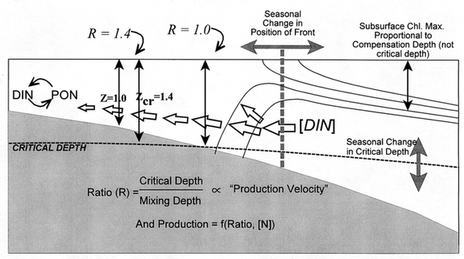Cross-Frontal Exchange and Scotian Shelf Cross-over Workshops
10-12 October, 2000
Holiday Inn, Falmouth, Massachusetts
|
Cross-Frontal Exchange and Scotian Shelf Cross-over Workshops 10-12 October, 2000 Holiday Inn, Falmouth, Massachusetts |
|
Overview
Cross-Frontal Exchange
Presentations
|
Front in Terms of Productivity A Biological Definition of the Georges Bank Tidal Mixing Front D.W. Townsend (University of Maine) A fundamental biological description of the tidal mixing front on Georges Bank can take any number of formulations, depending on the target "biology" or trophic level of interest. But with reference to the overall levels of primary production in the general vicinity of the front, as well as on either side of the front during the stratified season, we might consider the processes diagrammed schematically below. 
We know that the position of the tidal front changes both fortnightly, with spring-neap tidal cycles, and seasonally, as thermal stratification develops around the periphery of the Bank. This is indicated by the thick, vertical dashed line and arrow in the diagram. In addition, we know that the critical depth (the depth to which overlying integrated primary production is equal to the integrated respiration) also varies seasonally as a function of light (sun angle and day length) which increases from the winter solstice to the summer solstice. The level of primary production in the frontal region and the shallower tidally mixed waters of the Bank will be some function of nutrient concentrations (and hence the flux of new nutrients into the mixed side of the front) and the rate of primary production, which is likely controlled by light, assuming that nutrients are not limiting. Thus we can construct a ratio of the critical depth to the mixing depth which will be proportional to this production rate or velocity. Primary production in surface waters of the stratified side of the front will be dictated more by vertical nutrient fluxes across the pycnocline than by the relatively high light levels there. Production in the subsurface chlorophyll maximum layer, which commonly occurs along the pycnocline/nutricline, will be dictated by the compensation depth, since these waters are not undergoing vertical excursions in the sense that tidally mixed waters are. (The compensation depth is the depth to which the compensation light intensity penetrates; the compensation light intensity is that which allows photosynthesis to equal respiration). Thus, the overall levels of primary production will be controlled by the changes in position of the front and critical depth, both of which will contributed to variable "R", assuming no nutrient limitations. However, we know that nutrients (nitrogen and silica) do become limiting in the tidally-mixed crest region of the Bank immediately following the winter-spring phytoplankton bloom. Subsequent primary production throughout the remainder of the year will be dependent to some extent upon the magnitude of cross-frontal and cross-isobath fluxes of new nutrients (shown as open arrows), but will most likely be controlled primarily by recycled nutrients at central Bank locations farthest away from the front (shown by the cycling between DIN [dissolved inorganic nitrogen] and PON [particulate organic nitrogen]). |